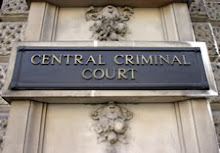NEWGATE to the CENTRAL CRIMINAL COURT.
NEWGATE GAOL , THE OLD BAILEY SESSIONS HOUSE and THE CENTRAL CRIMINAL COURT

THE SESSIONS HOUSE , Old Bailey , London.
Serious crimes in most of England were tried by travelling justices at Assizes held in temporary and full time courtrooms. The assize system did not apply to the City of London or Middlesex. The accused were held in Newgate Gaol and there were 8 annual sessions of the commissions of “Oyer and Terminer” ( to hear and determine ).
Until the 16th Century there was no specific courthouse for trials but the Sheriffs and Corporation of the City would hire rooms close to Newgate Gaol.
A charter by Henry the First in 1132 authorised the people of London to elect their own justiciar for “keeping the pleas of the Crown”. In 1461 a further charter gave the Lord Mayor greater powers and extensive rights and the title of “Justice of Gaol Delivery for Newgate”.
With the Old Bailey policed by a City of London Constabulary, the Lord Mayor had the right to “try, hear and determine” all offences coming within the jurisdiction of the Old Bailey. By right he could at any time seek a private audience with a monarch as an ex-officio member of the Privy Council and had the rank of an Earl.
The original Newgate Gaol was controlled by the Sheriffs of the City of London who also appointed a Keeper of the Prison. Common Serjeant John Westone’s complaint , made to the Court of Common Council in 1406 , re. obscenities and corruption at Newgate, resulted in a tower built next to Newgate to house female prisoners. Disease was rife and in 1414 the Keeper of Newgate and 64 inmates died of the plague. Newgate was remodelled in 1423 with money left by the Lord Mayor upon his death. It had five levels and included a dining-hall. Over time the building expanded and included adjacent buildings.
Keepers of Newgate often tortured and stole money from prisoners including their belongings. They also had to pay fees to turnkeys ( jailers ) for being released from shackles. The Keeper of 1449, William Arnold was imprisoned for raping a female prisoner.In 1539 a resolution was passed by the Court of Aldermen and then by the Court of Common Council, that a purpose-built Sessions House (the very first Old Bailey ) be built by 1550.

Note the windmll on top of the building.
Newgate had a windmill placed on its roof to ventilate air and to be used an an extractor fan due to the stench from the cells. Sweet-smelling herbs and strong vinegars were placed around the courtrooms. Newgate was badly damaged in the Great Fire of London in 1666 and was rebuilt in 1672. It could hold 150 prisoners but usually held between 250-300, most waiting for trial so it would only be for a few weeks. Debtors could be held for years.
The south side of the building held an exercise yard (“Press Yard“) which measured 9’ x 50’. Overlooking it was the Keeper’s house and a two-storey building known as the “Master’s Side”, with the best and most expensive lodgings for inmates.
In 1726, 21 men and women were hanged at Tyburn but 83 died in Newgate ; 92 died in 1729 and 62 in 1750 when two judges , the Lord Mayor, a number of Aldermen, several jurors and members of the public from the galleries were struck down and died.
The new prison building was designed by George Dance the Younger and was completed in 1780 but badly damaged during the Gordon Riots.
THE GORDON RIOTS
Led by Lord George Gordon, as president of the Protestant Association, its aim was to repeal the Catholic Relief Act of 1778 by George the Third which relieved the suffering of Catholics in society. In 1780 the association marched on the House of Commons. The crowd of 60,000 had been infiltrated by rioters and looters. Roman Catholic churches and public buildings were damaged and robbed. Newgate Gaol came under attack at a few minutes past 6pm on the 6th of June. Mr. Akerman, the Keeper of the Gaol , locked himself in one of his rooms. After setting fire to his belongings the crowd turned on the rest of Newgate. They broke into the rest of the building via the roof. Ladders were used to descend and release chained prisoners. They were taken away on horseback , some still wearing chains that could not be easily removed. Troops were used to quell the rioters. Newgate’s thick stone walls had held and survived. The rioting had lasted for 5 days; over 800 persons were killed;approximately 135 persons were tried for rioting, looting and destruction of property. Fifty nine were convicted and at least 33 rioters were hanged. Lord Gordon was arrested for incitement and assisting the insurrection. He was held in the Tower of London for 8 months then tried before the Court of Kings Bench for treason. His defence counsel, Thomas Erskine, made a stirring speech that went on past midnight. The jury came back at 5am with a not guilty verdict. He was convicted of libel in 1787 and 1788. He was imprisoned in the newly built Newgate and died there of gaol fever in 1793.

NEWGATE ABLAZE
Prisoners were allowed to keep dogs in cells until 1792 and pigs and poultry until 1814. Between 1700 and 1707 the deputy keeper, William Robinson, practically turned Newgate Prison into a brothel allowing “lewd women and common strumpets” to lie there all night. City Aldermen visited Newgate in 1707 and found that Robinson allowed male and female prisoners to spend the night together for one shilling or visit one another for sixpence.
In 1770 an Act of Parliament stated that construction of a “ new and commodious jail “ should begin. Included in the rebuild of Newgate Gaol was the reconstruction of the Sessions House. The “new” Sessions House in Old Bailey was built in 1774. In 1775 the Court of Common Council reported to the City Corporation that Newgate Gaol was “ incapable of improvement or tolerable repair” and that “it is overcrowded with victims of public justice, under the complicated distresses of poverty, nastiness and disease”.
Debtors were moved in 1815 from Newgate to other local prisons. It had been built to hold 500 prisoners but held over 800 and at one point it held over 1,100. A typical ward was about 15’x 30’ and usually held up to 15 men, though sometimes double that figure. Further rebuilding occurred in 1857 and 1858. Crowded wards were replaced by a block of 5 floors of cells built around galleries. A similar block for female detainees was built in 1862. It was abolished in 1834 and was replaced with the Central Criminal Court.
Reform came and the grisly procession from Newgate to Tyburn for execution was to cease and over 600 years of public entertainment and tradition was to disappear. All future executions were to take place on Old Bailey ( street ) itself outside the Debtors Door of Newgate Gaol. On the morning of 7th November 1783 the last hanging procession took place from Newgate to Tyburn. The man sentenced to death was John Austin, convicted at the Sessions House of robbing and wounding John Spicer. He stood on the back of a horse-drawn cart , the noose in place , dropping and dangling as the cart pulled away. Another method was to have the noose in place, the prisoner climb a ladder then he would have the ladder kicked away when he least expected it. He would be strangled by the rope.
On 9th December 1783 the street outside the Sessions House became the official place of execution. Three crossbars meant the possibility of multiple executions. The prisoner would stand on a trap-door that was held in place with a pin. A noose was placed under and slightly behind the left ear. The bolt was removed, the trap fell open and the prisoner plunged into the pit below. The first morning saw 10 prisoners executed. Just over a year later a block hanging of 20 prisoners occurred.
Four hundred years after the charter of 1461 it was disputed whether the charter was right to give the Lord Mayor the right to sit as First Commissioner at the Old Bailey of if it was through virtue of his title. The doubt ended when the Central Criminal Court Act was passed by Parliament in 1834; it confirmed the ancient privilege by charter. It also extended the area the Old Bailey covered re. its jurisdiction. It went beyond London and Middlesex to parts of Essex, Kent and Surrey as well as overseeing indictments for murder, piracy and crimes upon the high seas. That was how the word “Central” came to prefix the previous “ Criminal Court”.
The court sessions took place 12 times each year. The building had been constructed with only one courtroom but with the great amount of court business a second courtroom was needed which was known as “the New Court “. A further two courtrooms were added by the mid 19th Century. By 1845 over 2,000 cases a year were being tried. The City Lands Committee of the Corporation of London reported in 1878, after a fire at the Sessions House caused so much damage the previous year, that to provide adequate accommodation for the proper holding of prisoners awaiting their trial and the growing amount of court cases, the old Sessions House should be pulled down and new courts and offices built on its site and adjoining premises. Trials at the Old Bailey attracted vast crowds and until 1860 there was an entrance fee to watch from the public galleries. This was pocketed by the Keeper of the Court.
The Prisons Act of 1878 also concluded that Newgate should cease being used as a prison for debtors with Sir William Harcourt , the Home Secretary, saying that Newgate should cease as a regular prison “except as a place of confinement for prisoners convicted of capital offences at the Old Bailey and awaiting execution”.

NEWGATE PRISON
Twenty years later it was agreed to build a modern and larger Old Bailey Sessions House on the site of the disused Newgate Prison. The last case heard at the ‘old’ Old Bailey was a case of arson ,which was dismissed due to lack of evidence. In the autumn of 1901 designs were invited and the plans of Mr.E.W.Mountford ,FRIBA, were accepted.
Newgate Prison was closed and demolished in 1902 with its contents ie shackles , doors, chairs etc. Being sold at auction. The last person to be hanged inside Newgate was murderer George Woolfe in May 1902.

The Central Criminal Court opened in 1907 . Lord Alverstone, the Lord Chief Justice, presided over the first big murder trial in the new building. Horace George Rayner was found guilty and declared sane ; he was reprived from execution and sent to Broardmoor.

No comments:
Post a Comment